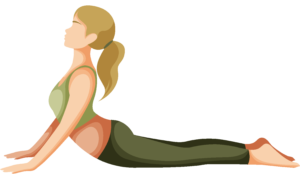Cobra (Bhujangasana)
Pose Overview
| Common Name | Cobra |
| Traditional Sanskrit Name | Bhujangasana |
| Sanskrit Name Pronunciation | boo-jang-GAHS-uh-nuh |
| Pose Difficulty | Beginner |
| Drishti
Drishti is the gaze or visual focus point during yoga poses.
Learn more about Drishti |
Upward, towards the sky |
Cobra, or Bhujangasana in Sanskrit, is a yoga pose that is said to be beneficial for strengthening the back, arms, and core. The name of the pose comes from the fact that it resembles a cobra, with the body lifted off the floor and the arms extended behind the body. The pose is said to be helpful for increasing flexibility and strength in the back and core, and for promoting a sense of balance and focus. It is also said to be beneficial for relieving stress and anxiety, and for promoting a sense of inner peace.
Benefits of Cobra
Strengthens the muscles of the back and arms Improves posture Stretches the chest, shoulders, and abdomen Stimulates the organs of the abdomen Can relieve stress and fatigue
How to Enter Cobra
Lie on your stomach with your hands placed under your shoulders and your elbows close to your body As you inhale, press into your hands and straighten your arms, lifting your chest off the floor Keep your shoulders relaxed and down away from your ears, and gaze forward or slightly upward
How to Exit Cobra
Release the pose by lowering your chest back to the floor and resting your forehead on the ground
Common Cobra Modifications & Variations
Beginners can start with a modified version of the pose by keeping their elbows close to the body and using their hands for support instead of lifting the chest off the floor Advanced practitioners can try lifting one arm at a time for a deeper stretch
Common Mistakes with Cobra
Rounding the lower back Pushing the hips too high Overarchin the neck
Safety Guidance
Those with any lower back injury should avoid this pose Those with high blood pressure should also avoid this pose

